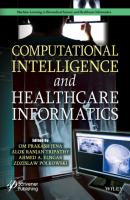Computational Intelligence and Healthcare Informatics. Группа авторов
Чтение книги онлайн.

Читать онлайн книгу Computational Intelligence and Healthcare Informatics - Группа авторов страница 21
Название: Computational Intelligence and Healthcare Informatics
Автор: Группа авторов
Издательство: John Wiley & Sons Limited
Жанр: Программы
isbn: 9781119818694
isbn:
2.4 Comparison of Existing Models
In this section, existing models are compared on many different parameters as listed in Table 2.2.
1 Model parameters: type of model used, input image size, number of layers epoch, loss function used, and accuracy.
2 Accuracy achieved for all 14 different pathologies and dataset used for experimentation.
3 Other metrics: model used, specificity, sensitivity, F1-score, precision, and type of pathology detected.
4 On the basis of hardware and software used and input image size.
Table 2.2 shows datasets and pathologies detected by various DL models. It is observed that ChestX-ray14 is the most preferred dataset which can be used for training and testing of newly implemented models in the future. Cardiomegaly and Edema are easy to detect as compared to other pathologies because of their spatially spread out symptom. In addition, Table 2.3 shows comparison among different models on the basis of AUC score for 14 different chest pathologies. It is observed that cardiomegaly is having the highest value of AUC score obtained by most ensemble models. Edema, Emphysema, and Hernia are the pathologies following cardiomegaly which are having better AUC. CheXNext [59] is able to detect Mass, Pneumothorax, and Edema more accurately which other models cannot detect.
Table 2.4 highlights the comparison between various models on the basis of other performance measure. Most of the models have used accuracy, F1-score, specificity, sensitivity, and PPV and NPV parameters for comparison with other models. Pre-trained networks like AlexNet, VGG16, VGG19, DenseNet, and ResNet121 trained from scratch achieved better accuracy than those whose parameters are initialized from ImageNet because ImageNet has altogether different features than CXR images.
Table 2.5 shows hardware used by different models along with size of input image in terms of pixels and datasets used. Due to computationally intensive task, high definition hardware of NVIDIA card with larger size RAM has been used.
Table 2.2 Comparison of different deep learning models.
| Ref. | Model used | Dataset | No. layers | Epoch | Activation function | Iterations | Pathology detected |
|---|---|---|---|---|---|---|---|
| [23] | DenseNet-121 | ChestX-ray14 | 121 | - | Softmax | 50,000 | 14 chest pathologies |
| [67] | Pretrained CNNs: | ChestX-ray14 | - | 50 | - | - | 14 chest pathologies |
| [7] | VDSNet | ChestX-ray8 | - | - | ReLU | - | Pulmonary diseases |
| [10] | DualCheXNet | ChestX-ray14 | 169 | - | ReLU | - | 14 chest pathologies |
| [2] | CNN | ChestX-ray8 | 5 | 1,000–4,000 | ReLU | 40,000 | 12 chest pathologies out of 14 |
| BPNN | 3 | - | 5,000 | ||||
| CpNN | 2 | - | 1,000 | ||||
| [8] | Customized U-Net | ChestX-ray8 | 35 | 100–200 | ReLU | 20 | Cardiomegaly |
| [47] | Ensemble of DesnSeNet-121, DenseNet-169, DenseNet-201, Inception-ResNet-v2 Xception, NASNetLarge | CheXpert | 5 | Sigmoid | 50,000 | Only 5 pathologies: Atelactasis, Cardiomegaly, Pleural, Effusion, and Edema | |
| [51] | STN based CNN | Lung ultrasonography videos | - | - | ReLU | - | COVID-19 Pneumonia |
| [46] | Ensemble with AlexNet | NIH Tuberculosis Chest X-ray dataset [10.31] and Belarus Tuberculosis Portal dataset [10.32] | - | - | ReLU | СКАЧАТЬ